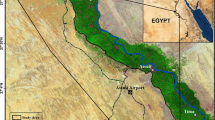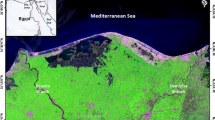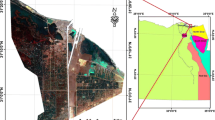Abstract
Semarang is one of the biggest cities in Indonesia and nowadays suffering from extended land subsidence, which is due to groundwater withdrawal, to natural consolidation of alluvium soil and to the load of constructions. Land subsidence causes damages to infrastructure, buildings, and results in tides moving into low-lying areas. Up to the present, there has been no comprehensive information about the land subsidence and its monitoring in Semarang. This paper examines digital elevation model (DEM) and benchmark data in Geographic Information System (GIS) raster operation for the monitoring of the land subsidence in Semarang. This method will predict and quantify the extent of subsidence in future years. The future land subsidence prediction is generated from the expected future DEM in GIS environment using ILWIS package. The procedure is useful especially in areas with scarce data. The resulting maps designate the area of land subsidence that increases rapidly and it is predicted that in 2020, an area of 27.5 ha will be situated 1.5–2.0 m below sea level. This calculation is based on the assumption that the rate of land subsidence is linear and no action is taken to protect the area from subsidence.








Similar content being viewed by others
References
Abidin HZ, Rachman D, Darmawan D, Hadi S, Akbar A, Rajiyowiryono H, Sudibyo Y, Meilano I, Kasuma MA, Kahar J, Subarya C (2001) Land Subsidence of Jakarta (Indonesia) and its geodetic monitoring system. Nat Hazards 23:365–387
Abidin HZ (2005) Suitability of levelling, GPS and INSAR for monitoring land subsidence in urban areas of Indonesia. GIM Int 19(7):12–15
Arbriyakto D, Kardyanto D (2002) Assessment of the physical-houses and social loss of the people in Semarang coastal area (In Indonesian). In: Proceedings of seminar on impact of the sea level rise in coastal urban area in Indonesia. Bandung, Indonesia 12–13 March, pp 128–157
Bhattacharya AK, Basak S, Patra MN (2004) Land subsidence in Calcutta under the effect of hydrogeological conditions and over-withdrawal of groundwater. Electron J Geotech Eng 9E
Cassiani G, Zoccatelli C (2000) Subsidence risk in Venice and nearby areas, Italy, owing to offshore gas fields: a stochastic analysis. Environ Eng Geosci 6(2):115–128
Chai J-C, Shen S-L, Zhu H-H, Zhang X-L (2004) Land subsidence due to groundwater drawdown in Shanghai. Geotechnique 54(2):143–147
Development Planning Board of Semarang (DPB) (2002) Semarang City Planning 2000–2010 (In Indonesian). Government of Semarang, Indonesia
Gutiérrez F (2004) Origin of the salt valleys in the Canyonlands section of the Colorado Plateau Evaporite-dissolution collapse versus tectonic subsidence. Geomorphology 57(3, 4):423–435
Hamdani Y, Mareschal J-C, Arkani-Hamed J (1994) Phase change and thermal subsidence of the Williston Basin. Geophys J Int 116(3):585–597
Hasan SE (1996) Subsidence hazard from limestone mining in an urban setting. Environ Eng Geosci 2(4):497–505
ILWIS (2000) Integrated land and water information system. Geographic Information System. Version 3.1. International Institute for Geo-Information and Earth Observation, ITC, Enschede, The Netherlands
Kobayashi H (2003) Vulnerability assessment and adaptation strategy to sea-level rise in Indonesian coastal urban area. National Institute for Land and Infrastructure Management, Ministry of Land, Infrastructure and Transport, Asahi-1, Tsukuba-city, Japan. http://www.sim.nilim.go.jp/GE. Cited 20 Jul 2005
Lamont-Black J, Baker A, Younger PL, Cooper AH (2005) Utilizing seasonal variations in hydrogeochemistry and excitation-emission fluorescence to develop a conceptual groundwater flow model with implications for subsidence hazards: An example from Co. Durham, UK. Environ Geol 48(3):320–335
Marfai MA (2003) GIS modelling of river and tidal flood hazards in a waterfront city: case study, Semarang City, Central Java, Indonesia. M.Sc. thesis, International Institute for Geo-Information and Earth Observation, ITC, Enschede, The Netherlands. http://www.itc.nl/library/Papers_2003/msc/ereg/marfai.pdf. Cited 20 Apr 2003
Marfai MA (2004) Tidal flood hazard assessment: modelling in raster GIS, case in western part of Semarang coastal area. Indones J Geogr 36(1):25–38
Marfai MA, Sudrajat Budiani SR, Sartohadi J (2005) Tidal flood risk assessment using iteration model and Geographic Information System. The Competitive Research Grant scheme no ID: UGM/PHB/2004 (In Indonesian). Research Centre, Gadjah Mada University, Yogyakarta, Indonesia
Mousavi SM, Shamsai A, El Naggar MH, Khamehchian M (2001) A GPS-based monitoring program of land subsidence due to groundwater withdrawal in Iran. Can J Civil Eng 28(3):452–464
Public Work Department of Semarang (PWD) (2000) Semarang urban drainage master plan project (In Indonesian). Public Work Department, Semarang, Indonesia
Rathje EM, Wright SG, Karatas I, Bachhuber J (2003) Coastal subsidence in Golcuk during the 1999 Kocaeli Earthquake in Turkey. In: Proceedings of the International Offshore and Polar Engineering Conference, pp 1160–1167
Sun H, Grandstaff D, Shagam R (1999) Land subsidence due to groundwater withdrawal: Potential damage of subsidence and sea level rise in southern New Jersey, USA. Environ Geol 37(4):290–296
Sutanta H (2002) Spatial modeling of the impact of land subsidence and sea level rise in a coastal urban setting, case study: Semarang, Central Java, Indonesia. M.Sc. thesis, International Institute for Geo-Information and Earth Observation, ITC, Enschede, The Netherlands
Sutanta H, Hobma TW, Damen MJ, Voskuil RPGA (2003) Preliminary assessment of the Impact of Land Subsidence and sea level rise in Semarang, Central Java, Indonesia. Ilwis Execise handbook, Refreshing course in Geo Information for hazard and disaster management, Gadjah Mada University, Yogyakarta, Indonesia and International institute for geo-information sciences and earth observation, ITC, Enschede, The Netherlands
Sofner B, Schmidt G (2002) Groundwater studies in urban centre of Indonesia, Federal Institute for geosciences and Natural Sciences, Hannover, Germany
Tobing MHL, Syarief EA, Murdohardono D (1999) Research of the geo-technique aspect of the land subsidence in Semarang (In Indonesian). Directorate of Environmental Geology, Department of Mine and Energy, Bandung, Indonesia
Acknowledgments
This article derives from research in progress by M. A. Marfai on Risk assessment of tidal inundation under the scenarios of sea level rise and land subsidence at the Justus-Liebig-University Giessen, Germany, supported by The German Academic Exchange Service (DAAD). The authors express their gratitude to Mr. Rosyid (Semarang Public Work Department) for providing valuable benchmark data and the reviewers for their helpful advice.
Author information
Authors and Affiliations
Corresponding author
Rights and permissions
About this article
Cite this article
Marfai, M.A., King, L. Monitoring land subsidence in Semarang, Indonesia. Environ Geol 53, 651–659 (2007). https://doi.org/10.1007/s00254-007-0680-3
Received:
Accepted:
Published:
Issue Date:
DOI: https://doi.org/10.1007/s00254-007-0680-3




